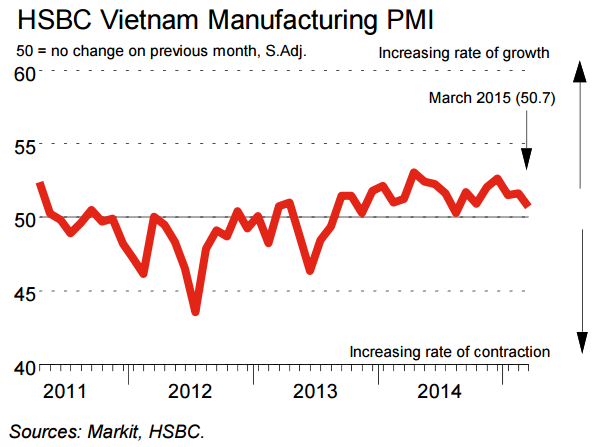HSBC: Current sequence of output growth extends to year-and-a-half
HSBC: Current sequence of output growth extends to year-and-a-half
The Vietnamese manufacturing sector continued to see improving operating conditions at the end of the first quarter of 2015 as output and new orders rose again. Falling prices were again a feature of the latest survey, with firms passing reduced input costs on to their clients. Meanwhile, staffing levels decreased modestly.

The headline seasonally adjusted Purchasing Managers’ Index™ (PMI™) – a composite indicator designed to provide a single-figure snapshot of operating conditions in the manufacturing economy – posted 50.7 in March, down from 51.7 in February but still signalling a strengthening of business conditions in the sector. Operating conditions have now improved in each of the past 19 months.
Central to the latest improvement in business conditions were further rises in both output and new orders. Manufacturing production increased for the eighteenth successive month, and at a solid pace. Panellists reported that higher new orders had been the main factor leading output to increase, while a greater availability of raw materials had also contributed to growth.
New business continued to rise in March, albeit at a modest pace that was the slowest since October 2014. Meanwhile, new export orders increased, following a fall in the previous month. Anecdotal evidence suggested that competitive pricing had helped companies to secure more new work from abroad.
As the rate of growth in overall new business eased and production increased, manufacturers were able to work through backlogs of work during the month. Moreover, the solid depletion in March was the fastest since September 2014.
After having increased in each of the previous six months, manufacturing employment in Vietnam decreased during March. That said, the rate of job shedding was only modest. Employee shortages at suppliers were mentioned by firms that saw a deterioration in vendor performance during the month, with supplier lead times lengthening for the first time since September 2014.
A further sharp decline in input costs was primarily linked to lower fuel prices, while other commodities such as steel were also reportedly down in price. Input costs have now decreased in each of the past five months. Firms continued to pass on lower input costs to their clients through reduced output prices. Charges have fallen in each month since October 2014, but the latest decline was the slowest in four months.
Purchasing activity continued to increase in line with rising production, extending the current sequence of growth to 19 months. However, the latest rise in input buying was only slight, contributing to a solid fall in preproduction inventories.
Stocks of finished goods also decreased, and at the sharpest pace since June 2014. Panellists reported that the delivery of goods to clients had been behind the reduction, which followed a marginal increase in February.
Commenting on the Vietnam Manufacturing PMI™ survey, Andrew Harker, Senior Economist at Markit said: “The Vietnamese manufacturing sector continued its recent solid performance at the end of Q1, with firms able to secure greater numbers of new orders from both domestic and export clients. Falling commodity prices in world markets continued to feed through to lower input costs, with manufacturers in turn able to pass on cost savings to clients.”



















